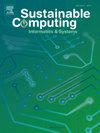用于预测全球水平辐照度的基于双向门控递归单元的新型叠加集合回归器
IF 3.8
3区 计算机科学
Q1 COMPUTER SCIENCE, HARDWARE & ARCHITECTURE
引用次数: 0
摘要
太阳能发电的快速发展带来了太阳能间歇性的新挑战,需要对全球水平辐照度(GHI)进行精确预测。准确预测全球水平辐照度对于将可持续能源纳入传统电网管理至关重要。文章提出了一种创新的解决方案--具有双向门控递归单元的新型增强堆集合(ESE-Bi-GRU),它使用机器学习(ML)提升回归器,如 Ada Boost、Cat Boost、Extreme Gradient Boost 和 Light Gradient Boost Machine,并将 Light Gradient Boost Machine 作为基础学习器,将双向的深度学习(DL)算法,如长短期记忆(LSTM)和门控递归单元(GRU)作为元学习器。与单个模型相比,对所提出的 ESE-Bi-GRU 模型的预测性能进行了评估,结果显示平均绝对误差 (MAE) 显著降低了 86.03%,均方根误差 (RMSE) 显著降低了 66.43%。该模型能够最大限度地减少 MAE 和 RMSE 等预测误差,为更有效地规划和利用零星太阳能资源带来了希望。通过提高 GHI 预测精度,ESE-Bi-GRU 模型有助于在更广泛的能源网中优化可持续能源的整合,促进更具可持续性和环保意识的能源管理方法。本文章由计算机程序翻译,如有差异,请以英文原文为准。
A bidirectional gated recurrent unit based novel stacking ensemble regressor for foretelling the global horizontal irradiance
The rapid expansion of solar power generation has led to new challenges in solar intermittency, requiring precise forecasts of Global Horizontal Irradiance (GHI). Accurate GHI predictions are crucial for integrating sustainable energy sources into traditional electrical grid management. The article proposes an innovative solution, the novel Enhanced Stack Ensemble with a Bi-directional Gated Recurrent Unit (ESE-Bi-GRU), which uses machine learning (ML) boosting regressors such as Ada Boost, Cat Boost, Extreme Gradient Boost, and Gradient Boost, and Light Gradient Boost Machine acts as a base learner and the deep learning (DL) algorithms such as Long Short-Term Memory (LSTM) and Gated Recurrent Unit (GRU) for both directions are taken as a meta-learner. The predictive performance of the proposed ESE-Bi-GRU model is evaluated against individual models, showing significant reductions in mean absolute error (MAE) by 86.03 % and root mean squared error (RMSE) by 66.43 %. The model's ability to minimize prediction errors, such as MAE and RMSE holds promise for more effective planning and utilization of sporadic solar resources. By improving GHI forecast accuracy, the ESE-Bi-GRU model contributes to optimizing the integration of sustainable energy sources within the broader energy grid, fostering a more sustainable and environmentally conscious approach to energy management.
求助全文
通过发布文献求助,成功后即可免费获取论文全文。
去求助
来源期刊

Sustainable Computing-Informatics & Systems
COMPUTER SCIENCE, HARDWARE & ARCHITECTUREC-COMPUTER SCIENCE, INFORMATION SYSTEMS
CiteScore
10.70
自引率
4.40%
发文量
142
期刊介绍:
Sustainable computing is a rapidly expanding research area spanning the fields of computer science and engineering, electrical engineering as well as other engineering disciplines. The aim of Sustainable Computing: Informatics and Systems (SUSCOM) is to publish the myriad research findings related to energy-aware and thermal-aware management of computing resource. Equally important is a spectrum of related research issues such as applications of computing that can have ecological and societal impacts. SUSCOM publishes original and timely research papers and survey articles in current areas of power, energy, temperature, and environment related research areas of current importance to readers. SUSCOM has an editorial board comprising prominent researchers from around the world and selects competitively evaluated peer-reviewed papers.
 求助内容:
求助内容: 应助结果提醒方式:
应助结果提醒方式:


